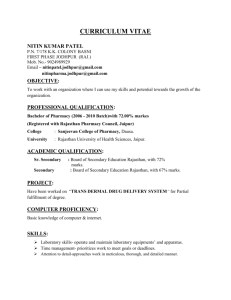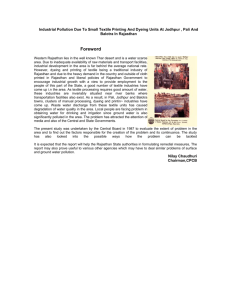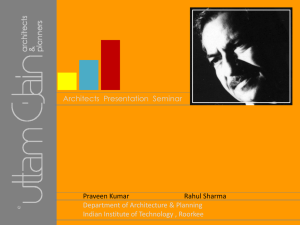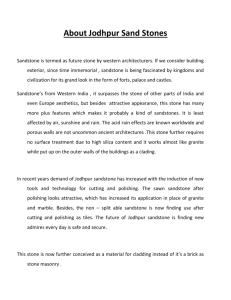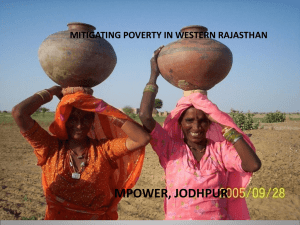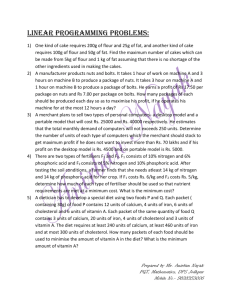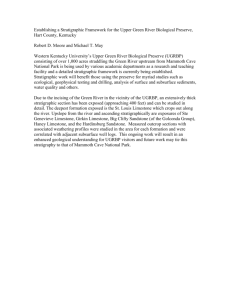geology & mineral resources of jodhpur district
advertisement
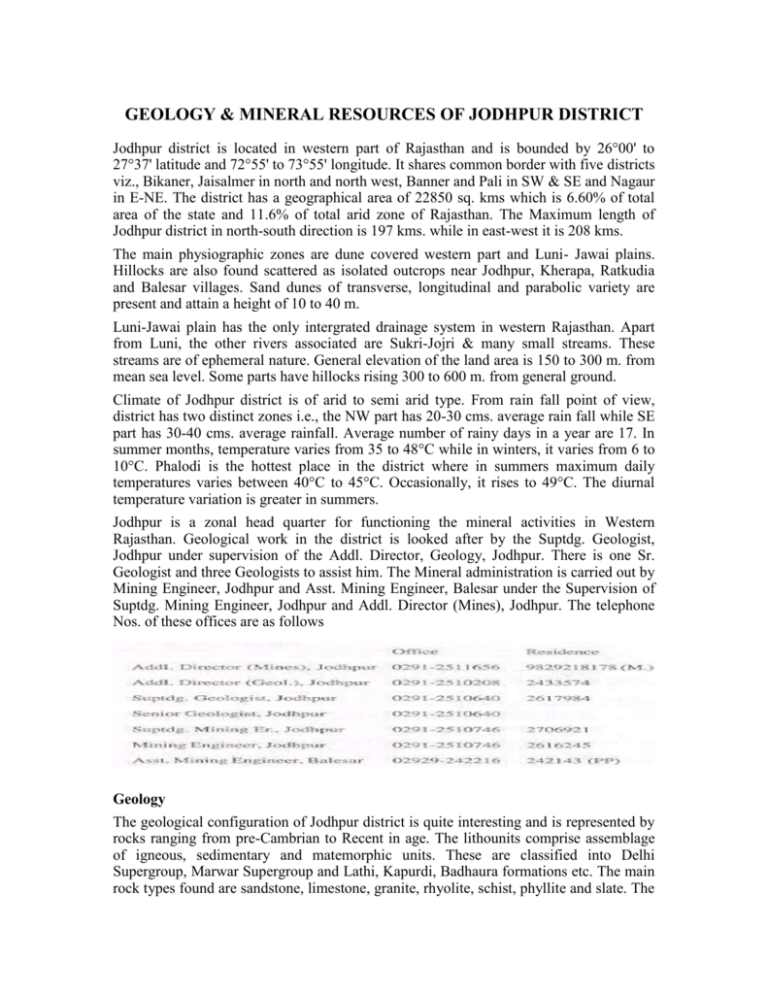
GEOLOGY & MINERAL RESOURCES OF JODHPUR DISTRICT Jodhpur district is located in western part of Rajasthan and is bounded by 26°00' to 27°37' latitude and 72°55' to 73°55' longitude. It shares common border with five districts viz., Bikaner, Jaisalmer in north and north west, Banner and Pali in SW & SE and Nagaur in E-NE. The district has a geographical area of 22850 sq. kms which is 6.60% of total area of the state and 11.6% of total arid zone of Rajasthan. The Maximum length of Jodhpur district in north-south direction is 197 kms. while in east-west it is 208 kms. The main physiographic zones are dune covered western part and Luni- Jawai plains. Hillocks are also found scattered as isolated outcrops near Jodhpur, Kherapa, Ratkudia and Balesar villages. Sand dunes of transverse, longitudinal and parabolic variety are present and attain a height of 10 to 40 m. Luni-Jawai plain has the only intergrated drainage system in western Rajasthan. Apart from Luni, the other rivers associated are Sukri-Jojri & many small streams. These streams are of ephemeral nature. General elevation of the land area is 150 to 300 m. from mean sea level. Some parts have hillocks rising 300 to 600 m. from general ground. Climate of Jodhpur district is of arid to semi arid type. From rain fall point of view, district has two distinct zones i.e., the NW part has 20-30 cms. average rain fall while SE part has 30-40 cms. average rainfall. Average number of rainy days in a year are 17. In summer months, temperature varies from 35 to 48°C while in winters, it varies from 6 to 10°C. Phalodi is the hottest place in the district where in summers maximum daily temperatures varies between 40°C to 45°C. Occasionally, it rises to 49°C. The diurnal temperature variation is greater in summers. Jodhpur is a zonal head quarter for functioning the mineral activities in Western Rajasthan. Geological work in the district is looked after by the Suptdg. Geologist, Jodhpur under supervision of the Addl. Director, Geology, Jodhpur. There is one Sr. Geologist and three Geologists to assist him. The Mineral administration is carried out by Mining Engineer, Jodhpur and Asst. Mining Engineer, Balesar under the Supervision of Suptdg. Mining Engineer, Jodhpur and Addl. Director (Mines), Jodhpur. The telephone Nos. of these offices are as follows Geology The geological configuration of Jodhpur district is quite interesting and is represented by rocks ranging from pre-Cambrian to Recent in age. The lithounits comprise assemblage of igneous, sedimentary and matemorphic units. These are classified into Delhi Supergroup, Marwar Supergroup and Lathi, Kapurdi, Badhaura formations etc. The main rock types found are sandstone, limestone, granite, rhyolite, schist, phyllite and slate. The general stratigraphic sucession of the rocks found in the district as established by GSI, is given below: Salient features of individual Groups/ Super groups are given below: Delhi Supergroup Lithounits of this formation mainly occur in eastern and southeastern parts of the district. Slate and phyllite associated with basic volcanics are found near Kaparda and Bhawai. This sequence has been further classified as Punagarh Group within Delhi Supergroup and is a low grade metamorphic assemblage. Post-Delhi interusives/Extrusives : These rocks are part of Malani igneous suite and cover large part of the district. The Malani suite commenced with a volacnic phase marked by felsic lava outpouring giving rise to tuff and rhyolite. This was followed by co-magmatic plutonic intrusions giving rise to Jalore-Siwana type granites. The effusives and intrusives are cut by a number of felsic and mafic dykes. Rhyolite is found in Jodhpur, Balesar and Bhopalgarh tehsils. The main localities are Chokri, Khejarla, Rawaniana and Salawas. Radiometric dating has given 745 # 10 M. Y. age for rocks of Malani Suite. Marwar Supergroup The oldest sedimentary sequence of Western Rajasthan comprising siliciclastic and carbonate sediments of Cambrian age are designated as Marwar Supergroup. Earlier, this was considered to be equivalent to Vindhyan rocks, but is now equated with sediments of Indus basin. This supergroup has been further sub divided into Jodhpur, Bilara and Nagaur Groups. Jodhpur Group is the oldest among these and has rock assembage shale, chert, fine grained to gritty sand stone. Rocks of this group cover a large part in Jodhpur, Bhopalgarh and Kherapa areas. Quarries of famous Jodhpur building stone are located in the rocks of this group. Rocks of Jodhpur Group were deposited on basement of Malani rocks. Bilara Group of rocks represent calcareous facies having dolomite, chert and limestone. These occur between Phalodi to Nagaur and from Bilara to Bournda and are overlain by mottled sandstone, c1aystone and gypseous beds. Permo-Carboniferous, Jurassic & Tertiary Formations Rocks younger than Marwar Supergroup occur in north western part of Jodhpur district. These cover small area and include Badhaura sandstone, Bap boulder bed of Permo-Carboniferous age, Lathi sandstone of Jusassic age and Kapurdi sandstone of Eocene age. Dune sand and alluvium are of Recenet age. Mineral Resources Minerals have been playing an important role in development of Jodhpur district for last many decades. The district is mainly rich in non-metallic minerals like sandstone, rhyolite, limestone, jasper, granite, clay, murram, kankar, brick earth, bajri etc. The important Major and minor minerals occuring in the district are : A. Minor Minerals 1. Jasper - This is a cryptocrystalline variety of silica having dark red colour. It has been found to be a good abrasive and is used in making grinding wheels. Jasper occurs in vein pocket like form associated with ferruginous sandstone/ dolomitic rocks near Mathania, Osiyan, Rundia, Sopra, Mogra, Lawera and Tamtia. At Present 15 leases have been sanctioned in the district covering 624.61 hect. area. Jasper of abrasive quality having above 90% Si02 is considered suitable for abrasive purpose. 2. Dolomite - Dolomite, a double carbonate of calcium and magnesium is a product of dolomitisation of pre-existing limestone. It can also form a primary deposit in evaporite sequence. It can have upto 21.7% MgO maximum. Dolomitc having high MgO with low silica percentage is a valuable industrial raw material for steel, refractory, glass and ferromanganese industries. Dolomite/dolomitic limestone occrrences are mainly confined to an east-west trending zone between Phalodi and Nagaur. It belongs to Pondlu formation of Bilara Group and comprises siliceous dolomite, dolomitic limestone and low silica dolomite (BF, SMS, refractory grade). Formations are horizontally disposed and occur as scattered outcrops in about 200 sq., kms. area. Low silica dolomite occurs interbedded with siliceous and dolomitic formations. Chert occurs as thin capping on dolomite. Geological investigations carried out by the department in Phalodi tehsil has proved two important blocks of low silica dolomite. These are i. Indo Ki Dhani - This area has BF/SMS grade dolomite associated with siliceous dolomite. Average thickness of low silica dolomite is 9.70 m. The cumulative thickness of all zones is 18.00 to 25 m. About 5 million tonne reserves have been assessed. ii. Indolai Ka Talao - 20 million tonnes of BF/SMS grade dolomite has been proved in this area. Cumulative thickness of dolomite varies from 5.90 to 24 m. It has 19-21 % MgO and 1 to 5% Si02. Overburden varies from 0.00 to 12 m. In addition to the above, indications of low silica dolomite have also been reported near villages Amla, Chhila, Lordiya, Shaitansingh Nagar also. All these occurrences have mixed assemblages of low silica dolomite, siliceous dolomite, dolomitic limestone etc. Keeping in view the intricacy of these deposits, only selective mining can yield low silica dolomite. No mining lease of dolomite is sanctioned in the belt. 3. Ball Clay - Good ball clay is reported from northern part of the district in tehsil Phalodi near village Kanasar-Mandli. Clay bed is about 1.50 m. to 3 m. in thickness. It can be used in ceramic, rubber & paint industry. No mining lease of clay is sanctioned in the area as most of the clay bearing ares lie in vicinity of Lift Canal. B. Minor Minerals The minor minerals occurring in the district are sandstone, limestone, marble, granite, rhyolite, murram, kankar-bajri and brick earth. Sandstone - This is an important building stone of whole of Western Rajasthan. History of its mining in Jodhpur district is 500 years old. Temples and Palaces in Jodhpur area are ample proof of sandstone's utility. Geologically the Jodhpur Sandstone belongs to Sonia and Girbhakar formations of Jodhpur Group. Sandstone is quarried for masonry stone (small block), slabs & aslets. Slabs are used for roofing purpose and aslet is used for making pillars and beams. Sandstone is buff-pink to grey colured, medium to coarse grained in nature and is well sorted. Recent researches have indicated that good quality splittable sand stone is confined to lower and middle facies of Jodhpur Group. Upper non-splittable, blockable thick beds of sandstone are also being used for making slabs, tiles, liries by using advanced cutting and sawing machines. The important occurrences of sandstone are located around Jodhpur city viz., Mandore, Soor-Sagar, Keru, Berli, Kailana, Balesar, Dechu, Setrawa, Chokri, Ratkudiya, Osiyan, Bhopalgarh etc. The sandstone occurs as hirozontally bedded fromation and assumes plateau like land shapes. The important mining areas of sandstone are located near Soorsagar, Fidusar, Balsamand, Mandore, Keru, Badli, Balesar, Setrawa, Kali-Bhuri Beri and Ghoda-Ghati. Sandstone mining is carried out under RCRLs/quarry licences, which are granted after delineation of suitable areas. Some areas of sandstone are granted under mining leases of 100 x 100 m. dimensions also. The size of quarry licence is 200 x 60 m. for which annual rent is to be paid and royalty is collected after production on dispatches. There are 42 mining leases and 10246 quarry licences existing in the district. There are many units established around city for sandstone processing, tile and pillar making. Handicraft items made out of sandstone are exported in international market. Limestones - This mineral finds multiple uses in variety of industries like cement, chemical, steel, sugar etc. There are number of limestone belts of cement to chemical grade occurring in Western Rajasthan. These belts are located in Jaisalmer, Jodhpur, Pali and Nagaur districts. Out of these most important are Sojat-Bilara-Gotan-Mundwa & Jaisalmer belts having cementJ chemical grade limestone. Sojat belt is 150 kms. long (Sojat to Rol Quazia) and 10 kms. wide. Extensive mining is going on for last many decades. Part of this belt passes through the eastern part of Jodhpur district. The important localities are Bilara-Ransigaon, Hariya Dhana, Borunda etc. Small occurrences of limestone are also observed near Basni Had Singh, Suwana, Basni-Darmi and Asop villages of Bhopalgarh tehsil. Department of Mines & Geology has carried out regional survey of Bilara-Borunda belt where bands of different grades of limestone were delineated. This limestone belt is an mixed assemblage of varied lithounits of Bilara Group, i.e. calcareous facies of Marwar Supergroup. The main rock types are limestone, dolomitic limestone and chert. Two types of limestones are found in this belt. One is greyish brown to black, fine grained laminated limestone. This is high grade limestone having 52% to 54% CaO and is used in lime burning and chemical industry. The other variety is coarse crystalline black limestone which has up to 52% CaO. It is used 'as sweetner in cement plants. Limestone and associated rocks occur as circular mounds and also as linear bands having 600 m. to 3 kms. strike length, 10 to 100 m. width and 3 to 5 m. thickness. Circular mounds have 200 x 200 m. to 100 x 100 m. dimensions. General trends of rock types is N 10° E to N 55° E with gentle dips (10°-45°). At places steep dips have been observed. Superimposed folding has resulted into series of synform-antiform structures. Limestone mined from this belt is used in cement, textile, sugar and lime burning industries. Hydrated lime is also prepared and marketed through out the country. The hydrated lime plants, kilns, cement units of Jodhpur-Pali districts also use limestone from this belt. Limestone of Suwana area is of chemical grade while that occuring around Asop is suitable for cement and lime burning. The overall chemical analysis of limestone of Bilara Borunda zone shown 47 to 54% CaO, 1 to 10% SiOz, and less than 2% MgO . On the basis of available data, regional assessment was attempted in Bilara-Borunda zone and 21 million tonnes and 11 million tonnes reserves of chemical and cement grade category, respectively, have been estimated. ACC and RSMDC have conducted drilling in small area and proved cement grade limestone. There are 78 mining leases granted in Jodhpur distt. from which 790539 tonnes of limestone produced during year 2003-04 and collected Rs. 267 .24lacs as royalty by the department. Granite - Granite in Jodhpur district is scattered over 150 sq. kms. area around Pipar, Khejarla, Chokri, Salawas, Madliya, Rawniana, Kosana, Kharia etc. It occurs as bouldery outcrops, sheet rock and as small ridges. It shows variety of colours and textures like porphyritic, coarse grained to equigranular. Colour varies from grey, pink, cream to redbrown. Jodhpur Granite has been classified as plutonic equivalant of Malani rhyolite. From above mentioned localities blocks of 1 cu. m. or large size can be easily mined out. At present 13 leases are sanctioned near Pipar, Khejarla, Chokri, Madaliya, Rawaniyana, Kosana etc. Blocks are also sent to Kishangarh and Abu Road for processing. Department has conducted preliminary appraisal of granite areas in 198990 and delineation was carried out in some areas. In addition to the above, granite occurrences have also been located by the department near Fitkasni, Salawas, Padasla Kalan etc. These are pink granites of Malani Igneous Suite. However, no mining lease exists in these areas. Rhyolite - Extrusive phase of Malani suite occupies large part of Jodhpur district. The type sections can be observed near Jodhpur city and Balesar Village. The important localities around Jodhpur are Kailana, Fort and Lalsagar. The four varities of rhyolite occuring in the district are columnarly jointed iginimbrite, welded tuff, pyroclastic and porphyritic. It forms a chain of ridges starting from Surpura in NE to Kailana in SW. Rhyolite flows also occur in Kakani-Mogra area along Jodhpur-Pali road. In Balesar area rhyolite forms low hummocks covered with sandstone. Similarly, in Jodhpur city also sandstone overlies rhyolites. Rhyolite is mainly used for making road ballast, gitti and chips and powder. Large number of crushers are under operation in Jodhpur- Kankani area, Guda Vishnoiya, Daizar, Sevki Kalan, Tulesar 'area. Chip & Powder is also sold to Gujarat and Maharashtra. Rhyolite of Kakani-Mogra area is suitable for manufacturing coloured glass. Rhyolite/ Perlite of Korna-Nagona-Deriya area is found suitable for industrial use. There are 69 ML sanctioned for rhyolite in the district from where 750.150 thousand tonnes of rhyolite was produced and earned Rs. 15.411acs as royalty during 2003-04. Marble - There is no known occurrence of true (marble) . in Jodhpur district, but siliceous dolomite occurring in northern part in the from of E- W trending belt from Moria- Munjasar-Denok to Tepu- Tekra in Phalodi tehsil, is being quarried as marble. Phalodi dolomite is siliceous in nature. It shows compositional bandings due to alternate layers of carbonate & silica. The fine hair line cracks have been filled by iron oxide which imports pink to buff colour of the rock. On polishing, these bandings are prominent and rock develops beautiful texture. This dolomite is being exploited as 'English teak wood Marble' for last few years from Moria-Munjasar area. A large number of entreprenurs are coming now a days to explore this dolomitic marble, available near village Chainpura, Palina, Moria-Munjasar, Sadavta, Tepu, Tekra, Sirdon, Amla, Chilla etc. At present there are 6 ML granted in Moria-Munjasar-Chainpura areas. The area could not be developed due to lack of adequate infrastructural facilities. Ochre - Low grade red-yellow ochre is found as 1-2 m. thick bed associated with sandstone near Pichiyak in tehsil Bilara. It is used for white washing of houses, floor, walls etc. Brick-Earth - Only one mining lease of brick earth is sanctioned in Kiron Ki Dhani. I Kankar-Bajri - Bajri is availaole in river-nala channels for which royalty is being collected by the department through contract system or by putting up departmental nakas. During year 2003-04 total Rs. 56.19 laces were collected as royalty/ permit fee. Masonry stone - A large number of leases have been granted for masonry stone. Rocks include sandstone, rhyolite. Their leases are granted in areas not included under R.C.R.L. Those areas where sandstone slabs are not excavated have been leased for masonry stone. There were 110 mining lease during year 2003-04 from which Rs. 74.84 lacs were collected as royalty. Borunda, Ghati, Bujhawad, Daizar, Gangana, Rohilla Kalan, Sar (Sawri-Bhakri) etc. are main localities from where masonry stone is produced. In addition to the above, recently department has located new areas of masonry stone near Osiyan, Tinwri, Bhopalgarh, Daizar etc. Salt - Salt occurs in form of brine solution near Malar-Bap area in north of Phalodi. Water is pumped out of wells and is spread in small shallow ponds. Salt is collected by evaporation method. Deptt. does not receive any royalty from salt as it is governed by Central Govt. Mineral Based Industries Mineral based industries have been developed in Jodhpur district in a systematic manner. There are total 13612 industries related to agriculture, farming, animals, cloth, chemical, Engineering, building & miscellaneous items. Handicraft, Guargum, stainless Steel, rerolling mills, textile cotton and acrylick industry, ready made garment, cement etc. are the major units installed in the district. There are about 15 EOU (Export Oriented Units) and the district. ranks at the IV th place in the State. There has been developed an inland containor depot (Dry Port) at Borunda Industrial area. Amongest mineral based industries cement, stone processing units, stone grinding & crushing units, hydrated & quick lime units, plaster of Paris units, emerystone units are the important mineral based industries. Stone processing units have provided employment to about 60,000 persons. The details are as follows Cement Industry - Limestone is being excavated in Bilara & Bhopalgarh tehsils for the manufacture of cement. There is one white cement plant in the district located near Kharia Khangar village. This is a unit of M/S Indian Rayon and has 80,000 TPA capacity. Its limestone requirement having 52% CaO, 2% Si02 and 0-1 % iron is made from Gotan area of Pali district. Stone Processing Units - There are 24 granite-marble processing units, all are located in Jodhpur. Most of the units are using small wheel cutters. Raw material is obtained from Chokri, Khejarla, Rawaniyana, Malawas, Madaliya & Kosana of Jodhpur district. Apart from this, raw material is also obtained from Barmer, Pali and Jalore districts. There are three large stone processing units located in Jodhpur. Massive sandstone of Jodhpur is now widely being used as decorative stone after processing. There are large number of sandstone cutting-polishing units intalled with advanced machines which are working round the clock to meet demand of this stone in handicraft industries and building industry. Emery stone Industry - Osiyan & Bhopalgarh tehsils of Jodhpur district are known for production of 100% jasper in the State. There are number of abrasive stone/emery stone units installed which are exporting the end product. Powder making Untis - There are 8 powder making units installed at Jodhpur, which are using bentonite of Barmer as a raw material and supplying the end product i.e. powder to oil exploration & steel industries. Plaster of Paris Units - There are 3 P.O.P. Units which are using gypsum of neighbouring districts i.e. Bikaner, Nagaur, Barmer & Jaisalmer, as a raw material. Stone Crushers - There are 22 crushers are operation in the district. Chips and powder is produced from rhyolite and it is widely used as a building and road material. Quick lime/Hydrated lime - The limestone of Bilara Borunda belt is also utilised for making quick lime and hydrated lime. These units are located near Pipar, Bilara, Borunda, Khejarla, Ransigaon and Haria Dhana Villages and also in Jodhpur city also. The products are sold to different parts of the country. Quick lime and hydrated lime of this area is preferred because of its high quality and purity. Possible Mineral based industries which may be come up in future a.Large reserves of limestone/dolomite are available in the district, as such industries based on these can be set up. b. There are large reserves of granite in Wester Rajasthan. Light coloured granite usually attract foreign buyers. As the processing & transporting facilities have been improving, there is a large scope of export of this rock. Jodhpur having ideal infrastructure is the most favourable site for this industry. c. U se of stone in handicraft is new. This industry is flourishing day by day by adopting use of machine & computers to prepare finished value added products. List of Unpublished Reports of Mineral Survey and Prospecting Work carried out by the Mines and Geology deptt. and Geological Survey of India in Jodhpur District (Available in the Directorate, Udaipur) Bhatti, G.: A report on the process for manufacturing simultaneously sulfuric acid and portland cement from gypsum and possibilities of standing the actual Mfg. out of raw material available in Jodhpur district. Bhargava, K.D. : A Report on magnesite deposit near Phalodi. F.S. 1958-59 Mehta, GM. : A note on the prospects of cement Industries in Jodhpur State. F.S. 195455 Bhola, K.L. : A note on the utilisation of selenite deposit of Jodhpur. Bhargava, M.K. Dave, Y.N. : A report on limestone investigation at Sojat and Bilara area, districts Pali and Jodhpur. F.S. 1966 Mehta, D.S. : Annual progress report of volcanic ash deposit in Barmer, Jaisalmer & Jodhpur circles. F.S. 1977 Mehta, D.S. & Sukhwal, O.S. : Investigation for dolomite and Jaspar around Mathania Bari, tehsil Osian. ES. 1977-78 Mehta, D.S. & Sukhwal. O.S. : Continuation of investigations for volcanic ash and rhyolite in Jodhpur area. F.S.1977-78 Mehta, D.S. & Raizada, R.K. : Study of various sandstone areas of Jodhpur district for opening new boundaries. F.S. 1977-78. Bafna, P.C. & Raizada, R.K. : Continuation of prospecting for location of new areas of sandstone. F.S. 1978-79. Bafna. P.C. & Purohit, S.N.: Reconnaissance for high grade limestone and economic minerals around Khirwa, Badhawa etc. in tehsil Phalodi. F.S. 1984-85. Ceramic Lab: Investigation report on clay from Beethe-Ka-Garh. F.S. 1989. Mehta, M.S. : Investigation for splittable sandstone by drilling near Surpura, BrahmanoKa- Tanka, Fidusar in Jodhpurdistrict. ES. 1988-39 Raizada, R.K. & Dhaka, B.S. : Reconnaissance for limestone and other economic minerals around Panchori, Chadi, Satika Kurd etc. at boarder region of Jodhpur & Nagaur districts. Reconnaissance for high grade limestone and dolomite around village Fora, Au, Kerla, Suwap in Phalodi tehsil, district Jodhpur. F.S. 1985-86-87 Bafna, P.C. & Purohit, S.N. : Reconnaissance for high grade limestone and economic minerals around Khirwa, Badhawa etc., tehsil Phalodi, district J odhpur. ES. 1984-85 Surana, L.S. & Goswami R.G. : Reconnaissance for splittable sandstone between villages Pichiyak, Birawas, Sambharia, Ransigaon, Begiki Dhani etc., distt. Jodhpur. Singh, S.P. & Mehta M.S. : Reconnaissance for dolomite and Marble n/v Moria Munjasar and Sutharon Ki Dhani in teh. Phalodi of distt. J odhpur. Singh, S.P. & Jamrani S.S. : Reconnaissance for marble and dolomite near villages Hem Singh Ki Dhani and Indolai ka Talab in tehsil Phalodi, distt. J odhpur. Goswami, R.G : Reconnaissance for fluorite, barytes and other economic minerals along with granite for use as decorative stone near villages Choki Kala, Khospura, distt. - J odhpur. Jamrani, S.S. : Geological appraisal of granites in Jodhpur district. Goswami, R.G. : Prospecting for lead and other associated minerals around village Sandara, teh. Sojat, distt. Pali. Maruka, R;K. : Regional mineral survey for high grade limestone in northern extension of Ghorawat, teh. Bilara, distt. Jodhpur. Dr. Bhanwara Ram. : Prospecting for economic minerals like fluorite, calcite, barytes & decorative stones like rhyolite around Badli, Choka, Agolai and Lalsagar area, distt. Jodhpur. Jamrani, S.S. : Prospecting for splittable sandstone and other economicm inerals in tehsil Shergarh, district Jodhpur. Jamrani, S.S.": Regional mineral survey and delineation of granite areas in Kharda Ki Dhani, Khejarla, Salawas etc. area of Pali and Jodhpur distts. Surana L.S. & Goswami R.G. : Final report of the project entitled reconnaissance for splittable sandstone between Killayes Ki Chyak, Birawas, Sambharia, Ransigaon, Bego Ki Dhani etc., distt. Jodhpur & other project entitled drilling for splittable sandstone between Pichyak & Ransigaon, distt. Jodhpur. Shekhawat, GS. : Regional mineral survey for splittable sandstone and clay around Balesar and Badli, tehsil Shergarh, distt. - Jodhpur. R.S.M.D.C. Ltd. : A preliminary geological appraisal of Hariyadhana limestne deposits, distt. Jodhpur. Jamrani, S.S. & Goswami, R.G. : Identification and delineation of marble areas in parts of Pali & Jodhpur distt. Jamrani, S.S. & Goswami R.G : Prospecting report on Phalodi dolomitic marble, distt. Jodhpur. Jhamrani, S.S. : Investigation for low silica dolomite and marble in Phalodi teh. of Jodhpur distt. Jhamrani S.S. : Investigation of low silica dolomite and marble in Phalodi teh. of Jodhpur distt. Mehta, M.S. : Investigation for refractory clay n\v Mandli, Kanasar, Beethe ka Gaon etc. in teh. Phalodi, distt.- Jodhpur. Jamrani S.S., Dubey S.: Exploration of dolomitic marble by drilling near village moria Munjasar-Palina, teh. Phalodi, distt. Jodhpur. Dubey, S. : Regional mineral survey and delineation for splittable sandstones around Hardhani, Chalaliya, Lavera, Kajnau, N andiya, Dudhiya villages, teh. Osiyan & Bhopalgarh, distt. Jodhpur. Mehta M.S. : Prospecting for molybdenum mineral around village Jurly near Bhavi, distt. Jodhpur. Mehta M.S. : Reconnaissance for refrectory clays and gypsum etc. n\v. Bap, Kamasar etc. in Jodhpur, Bikaner & Jaisalmer distts. Dr. Bhanwara Ram: Regional Mineral survey for limestone around villages Raj Singhpura, Basni Hari Singh and Asop, distt. Jodhpur & Exploration for limestone (a) by surface geological investigation nlv Darmi Basni Khurd, Harsolav and (b) by drilling near Basni Hari Singh, teh. Bhopalgarh along border of Jodhpur & Nagaur distt. Unpbulished Reports of Prospecting Work carried Out by G.S.I. In Jodhpur District Barman, G : Report on the study of stromatolites from the Marwar Supergroup of Jodhpur, Pali districts and lower Vindhyans of Chittorgarh district, Rajasthan. F.S. 197475 Barman, G. : Report on the study of stromatolites from the Marwar Supergroup in parts of Jodhpur and Nagaur districts, Rajasthan. F.S. 1975-76 Basu, J .K. : Quaternary and environmental studies in a part of Rajasthan desert area, Bikaner, Jaisalmer & Jodhpur districts, Rajasthan. F.S. 1979-80 Basu, J.K. : Report on investigation of locally available materials for road construction in parts of Bikaner, Jodhpur and Nagaur districts, Rajasthan. F.S. 1981-82 Bhatnagar, P.S. : Report on the geological mapping in parts of Jodhpur and Jaisalmer districts, Rajasthan. F.S. 1980-81 Bhushan, S.K. et al. : Report on geological mapping in parts of Jaisalmer, Barmer and Jodhpur districts with special reference to Malani igneous suitc. F.S. 1975-76 Bhushan, S.K. : Geology and structures of Malani igneous suite in parts of districts Barmer and Jodhpur, Rajasthan. F.S. 1976-77 Dasgupta, S. : A note on investigation onto cause of cracking and sinking of certain buildings in Sonaro Ki Ghatti, Jodhpur city, Rajasthan. F.S. 1960-61 Deshmukh, GP. et al. : Report on the traverses taken in search of phoshphorite in the western part of Jodhpur district, Rajasthan. F.S. 1966-67 Gathania, R.C. et al. : A report on systematic geological mapping of the Malani igneous suite in parts of Barmer, Jodhpur Jalore & Pali districts, Rajasthan. F.S. 1981-82 Khan, E.A. et al. : Progress report on the geological mapping and preliminary investigation of limestone in parts of Nagaur and Jodhpur, Rajasthan. Khan, E.A. : Report on geological mapping in parts of Jodhpur district, Rajasthan. 1969. F.S. 1968:-69 Khan, E.A. : Geological mapping in parts of Jodhpur and Nagaur districts, Rajasthan. F.S. 1969-70 Khan, E.A. : Report on geological mapping in Jodhpur-Pipar road area, district Jodhpur, Rajasthan. F.S. 1970-71 Khan, E.A. et al. : Geological mapping in parts of Jodhpur and Pali districts, Rajasthan. F.S. 1971-72 Mehra, S.L. : Report on the investigation for Phosphorite in parts of Pali, Jodhpur, Nagaur and Bikaner districts, Rajasthan. F.S. 1966-67 Mehta, D.R.S. et al. : Report on the investigation of gypsum deposits in Jodhpur state. F.S. 1948-49 Mukhopadhyay,A.K. : A report on the geological mapping and hydrogeochemical sampling for potash. F.S. 1973-74 Mukhopadhyay, A.K. et aI. : Report on the geological mapping in parts of Jodhpur and Barmer districts, Rajasthan. F.S.1973-74 Pareek, H.S. et al. : Stratigraphy, petrochemistry and petrogenesis of Malani volcanics in Jodhpur-Kailana talavAgolai-Undrio areas, distt. Jodhpur, Rajasthan. F.S. 1974-75 Raghupathi Rao, S. V. : Report on the geological mapping in parts of Jodhpur district, Rajasthan. F.S. 1976-77 Raghupathi Rao, S. V. et al. : Report on systematic geological mapping in parts of Bikaner, Nagaur, Jaisalmer and Jodhpur districts, Raj. F.S. 1982-83 Sengupta, S.R. : A report on the systematic geological mapping of Malani igneous suite of rocks in parts of Pali and Jodhpur districts, Rajasthan. F.S. 1978-79 Shah, S.C. : Reports on the study of early Permian beds of Bap-Badhawa area, Jodhpur districts, Rajasthan. F.S. 1979-80 Shah, S.C. : Report on the study of early Permian beds of Bap-Badhaura area, Jodhpur district, Rajasthan. F.S. 1980-81 Sinha, A. A.K. : Report on geological mapping in parts of Jodhpur district, Rajasthan. F.S. 1974-75 Sinha, A.A.K. et al. : Report on geological mappin in parts of Jodhpur district, Rajasthan. F.S. 1975-76 Sogani, P.C. et aI. : Systematic mapping in parts of Pali and }odhpur districts and preliminary investigation of limestone. F.S. 1963-64 Sogani, P.C. et al. : Report on the geological mapping and preliminary investigations for limestone in parts of Jodhpur and Nagaur districts, Rajasthan. F.S. 1966-67 Sogani, P.C. et al. : Geological mapping and preliminary investigations for limestone in parts of Pali, Jodhpur and Nagaur districts, Rajasthan. F.S. 1964-65. Srivastava, R.N. : Quarternary geological and geomorphological studies in parts of Jaisalmer and Jodhpur districts, Rajasthan. F.S. 1979-80. Srivastava, R.N. : A Report on environmental studies carried out in a part of Jodhpur urban and rural areas, Jodhpur district, Rajasthan. F.S. 1982-83. Sural, B. et al. : Geomorphological studies in parts of middle Luni basin, Pali & Jodhpurdistricts, Rajasthan. F.S. 1975-76 Sural, B. : Report on the geomorphological mapping, quaternary studies in middle Luni basin around Luni village covering parts of Jodhpur & Pali distts., Rajasthan. F.S. 197677. Venkoba Rao, V.R. : A report on the reconnaitory geological traverses in parts of the western Rajasthan. F.S. 1958-57. Mazumdar, K. et al. : Report on the systematic geological mappin in parts of Nagaur, Pali, Bikaner, Jaisalmar, Jodhpur and Churu districts, Rajasthan. F.S. 1983-84
